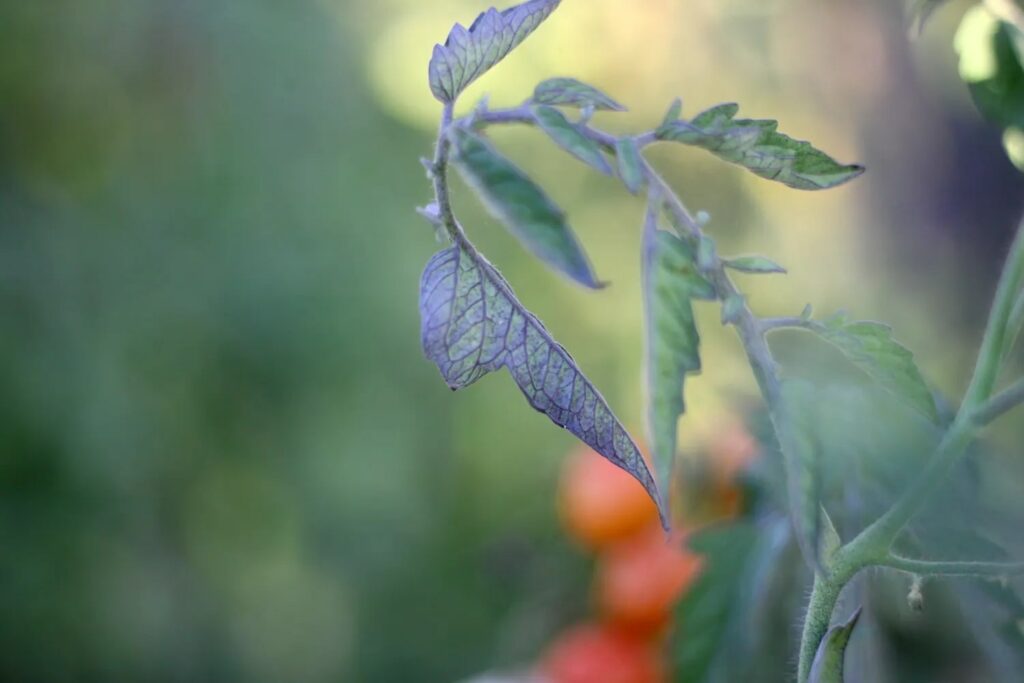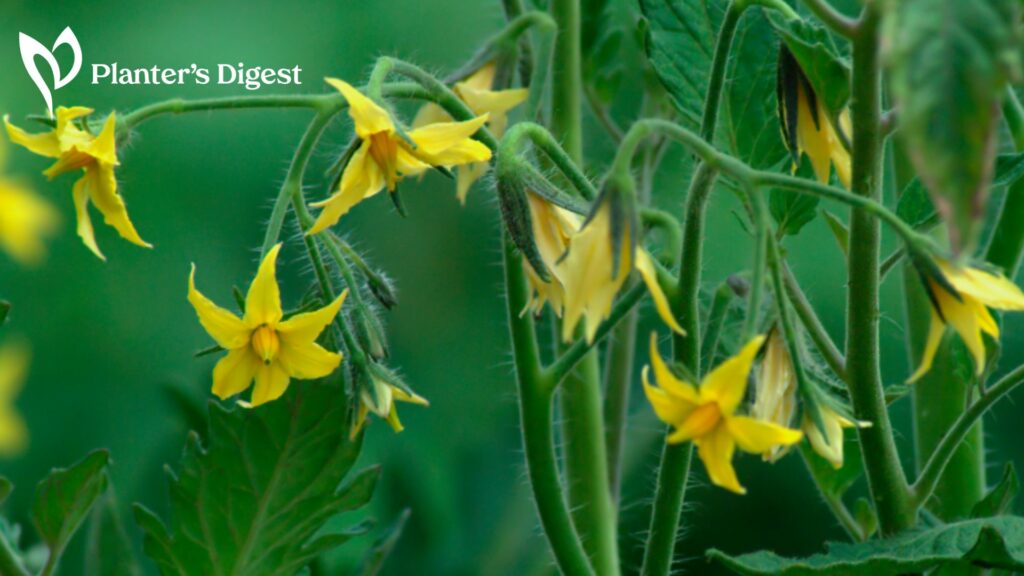Purple is a great color for many flowers, fruits, and leafy vegetables, including those in tomatoes. We actually rock these mystic colors from the lightest to the deepest shades!
But what if the original green leaves suddenly turned purple? Sounds like a genuine plant concern, wouldn’t you say?
If this is what you’re facing right now, or want to avoid this problem in the future, then we’ve got good news for you. We’ve listed all the possible reasons plus how to correct each!
Causes of Tomato Leaves Suddenly Turning Purple
The causes for the purple leaves in your tomato plant can range from temperature issues to nutrient deficiencies to pests and diseases. To help you understand your recent purple garden residents, let’s take a look!
Temperature Stress
The Fix: Minimize Temperature Stress
| Factors | Level |
| Ease | Moderate ●●○○○ |
| Maintenance Level | Low, depending on materials used |
| Estimated Costs | Low, depending on materials used |
| Possible Risks | Unforeseen temperature extremes |
Tomatoes are sensitive to extreme temperatures. Cold nights below 55 F or hot days above 90 F can cause temperature stress.
You might see the leaves turning purple, but don’t worry; it’s just a temporary response to the stress. As the plant adjusts to better conditions, the purple discoloration will likely go away on its own.
How to Minimize Temperature Stress
1. Protect seedlings.
Shield the plants from extreme weather conditions. On particularly hot days, consider using row covers or shade cloth to provide a respite from intense sunlight.
This will help prevent sunburn and dehydration.
2. Ensure minimal exposure to extreme weather.
When transplanting tomato seedlings, wait until the threat of frost has diminished. This precautionary measure ensures the young plants are not adversely affected by sudden temperature drops.
Alternatively, you can cover the seedlings or apply a layer of mulch around the plants. This helps to maintain the soil’s warmth during colder nights, safeguarding the roots from potential damage.
Phosphorus Deficiency
The Fix: Correct Phosphorus Deficiency
| Factors | Level |
| Ease | Low ●○○○○ |
| Maintenance Level | Low, depending on materials used |
| Estimated Costs | Moderate, depending on soil test requested |
| Possible Risks | Low to none |
Phosphorus is essential for healthy plant growth. Without enough phosphorus in the soil, tomato plants may show purple leaves, especially with older ones at the bottom.
This happens because of a phosphorus deficiency, which affects energy transfer and nutrient transport within the plant.
How to Correct Phosphorus Deficiency
1. Conduct a soil test.
Utilize soil testing kits, readily available for your convenience. These kits allow you to gauge the presence and severity of phosphorus deficiency in your soil.
If needed, consider engaging professionals or utilizing soil-testing facilities for a more comprehensive analysis of your soil’s phosphorus content.
2. Apply fertilizers with high phosphorus content.
Incorporate phosphorus-rich fertilizers, such as bone meal or rock phosphate, into the soil. Follow the manufacturer’s instructions closely to ensure proper application.
This practice will not only mitigate the deficiency but also enhance soil fertility and nutrient availability.
3. Improve soil health.
Introduce organic matter, like compost, into the soil. This aids in enhancing overall soil health and promoting nutrient retention, contributing to improved plant growth.
Potassium Deficiency
The Fix: Improve Potassium Levels
| Factors | Level |
| Ease | Low ●○○○○ |
| Maintenance Level | Low, depending on materials used |
| Estimated Costs | Moderate, depending on soil test requested |
| Possible Risks | Low to none |
Potassium plays a crucial role in multiple plant functions. These functions include absorbing water, activating enzymes, and carrying out photosynthesis. If the potassium levels are insufficient, you might notice purple or bronze discoloration in tomato plants.
Typically, this discoloration begins at the edges of the leaves and gradually spreads inwards.
How to Improve Potassium Levels
1. Conduct soil test.
Do a soil test to determine the potassium levels. This step is crucial in identifying if there is indeed a deficiency that needs to be addressed.
2. Improve potassium content.
Utilize potassium-rich fertilizers, such as potash or potassium sulfate. These fertilizers are effective in replenishing potassium levels in the soil.
3. Explore alternative and organic options.
Incorporate wood ash or kelp meal into the soil. These organic choices are valuable in increasing potassium levels naturally.
Magnesium Deficiency

The Fix: Balance Magnesium Content
| Factors | Level |
| Ease | Low ●○○○○ |
| Maintenance Level | Low, depending on materials used |
| Estimated Costs | Moderate, depending on soil test requested |
| Possible Risks | Low to none |
When tomatoes don’t get enough magnesium, their leaves might start showing a purplish color. They get a purple tinge, but the veins of the leaves stay green.
Now, magnesium is a special ingredient that tomatoes need to make chlorophyll. This is the element that helps them convert sunlight into food through a process called photosynthesis.
When there’s not enough magnesium, the photosynthesis process gets disturbed, and that’s when you see those purple patches on the leaves.
How to Balance Magnesium Content
1. Do a soil test.
Conduct a soil test to determine any nutrient deficiencies present in the soil.
2. Correct the magnesium levels.
Utilize a fertilizer containing magnesium, such as Epsom salt. This will aid in replenishing the magnesium levels in the soil.
When applying fertilizers, follow the application guidelines mentioned on the fertilizer package for optimal results.
3. Adjust soil pH levels.
Try incorporating dolomitic lime into the soil. This not only raises the soil pH but also provides a source of magnesium and calcium, benefiting overall plant health.
Cold Soil
The Fix: Increase Soil Temperature
| Factors | Level |
| Ease | Moderate ●●○○○ |
| Maintenance Level | Low, depending on materials used |
| Estimated Costs | Low, depending on materials used |
| Possible Risks | Low to none |
When the soil is cool or cold, tomato plant roots might find it challenging to absorb nutrients properly. This, in turn, can result in the leaves turning purple.
This is because the plants can’t get the necessary elements they need for their usual green color.
How to Increase Soil Temperature
1. Mulch the soil.
Consider using black plastic mulch or explore alternative types of mulch. This practice aids in retaining soil warmth and offers protective benefits to your plants.
2. Time tomato planting strategically.
Wait until later in the season when the soil has naturally warmed before applying mulch. This ensures that the soil temperature is suitable for the plants.
3. Consider other options.
Alternatively, you can use raised beds to expedite the process of warming the soil. Raised beds have the advantage of accumulating heat more quickly.
Viral Infections
The Fix: Remove Infected Plants
| Factors | Level |
| Ease | Low ●○○○○ |
| Maintenance Level | Low |
| Estimated Costs | Low to none |
| Possible Risks | Over pruning |
When these viruses attack, they can cause a few different symptoms. Symptoms can include the leaves turning yellow or developing a purple discoloration.
These viruses can mess with the plant’s usual growth processes. In turn, it affects how pigments are made and distributed in the leaves, leading to that purple look.
How to Remove Infected Plants
1. Address the infected plant immediately.
Promptly identify infected plants and remove them from the garden. Use clean and sterilized tools and safety gear when handling and removing infected plants.
Ensure proper disposal of the infected plants to prevent the virus from spreading. Destroying them is essential to prevent further contamination.
2. Prevent spread of viral infections
Maintain good hygiene during the removal and disposal process of infected plants. This helps prevent the transmission of the virus to other plants.
Use caution and avoid any actions that could potentially transfer the virus, such as touching healthy plants after handling infected ones.
Pests or Diseases
The Fix: Address Pests or Diseases Appropriately
| Factors | Level |
| Ease | Moderate ●●○○○ |
| Maintenance Level | Moderate, depending on materials used |
| Estimated Costs | Low, depending on materials used |
| Possible Risks | Low to none |
Pests and diseases are not good for tomato plants. They make the plants weaker and affect their health and ability to get nutrients.
Sometimes, pests and diseases can create purple spots or patches on the leaves. This can lead to making them look discolored.
How to Address Pests of Diseases Appropriately
1. Identify and act immediately on identified pests or diseases.
Inspect your plants regularly to identify any pests or diseases present.
Depending on the issue, consider methods such as hand-picking insects, using organic insecticides or fungicides, or introducing beneficial insects to control the problem.
2. Prevent future pest infestations and plant infections.
Maintain a clean garden environment by regularly removing debris, fallen leaves, and plant remains. This reduces potential hiding spots for pests and disease sources.
Avoid overcrowding plants. Proper spacing between plants allows for better airflow and reduces the likelihood of diseases spreading.
Sunlight Exposure
The Fix: Provide Proper Sunlight Exposure
| Factors | Level |
| Ease | Low ●○○○○ |
| Maintenance Level | Low, depending on materials used |
| Estimated Costs | Low, depending on materials used |
| Possible Risks | Can risk shock if not gradual exposure |
The strong sunlight can cause sunburn on young or delicate tomato plants. Sunburned leaves might show purple or dark spots due to cell and pigment damage in the plant.
How to Provide Proper Sunlight Exposure
1. Protect from strong sun exposure.
Offer shade to young plants, especially if you are in an area with strong and intense sunlight. This can be done using shade cloth, temporary coverings, or by strategically placing them under larger plants.
2. Encourage gradual sunlight exposure.
Assisting young plants in acclimatizing to full sunlight gradually can prevent sunburn and ensure their successful adaptation.
Over the course of a few days, expose the young plants to increasing amounts of sunlight. Start with shorter durations and gradually extend the exposure time.





